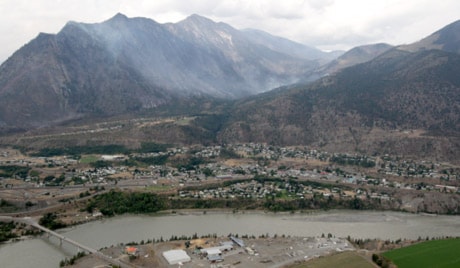VICTORIA — Steep mountain slopes, dead-dry trees and the threat of being bitten by black widow spiders are what an Ontario firefighter says he’ll remember most about his 19 days in the B.C. wilderness fighting forest fires.
Mike Kitney, 25, an Ontario Ministry of Natural Resources forest ranger, said he is returning to his Dryden, Ont., base Saturday with a new appreciation for firefighting work.
“The areas we were working were anywhere from 80- to 90-per-cent slope, and working in 40-degree temperatures. It was definitely something we had to get used to,” he said.
Kitney is one of about 600 firefighters from Ontario who came west to fight the forest fires that have forced the evacuation of thousands of people in British Columbia, including entire communities.
He was joined on the fire front by firefighters from Nova Scotia, Quebec, Manitoba and British Columbia. Firefighters from Australia and New Zealand also arrived late last week.
Critics say the influx of firefighting help is part of a predictable pattern in B.C., where unusually hot temperatures and dry conditions have combined to turn forests littered with trees dead from the pine beetle infestation into infernos.
It doesn’t have to be that way, they say.
Prof. Stephen Pyne of Arizona State University, who has studied forest fires in countries around the world and in Canada specifically, said Canada is more focused on the emergency response.
“Fire management is a part of land management, and this is where, if I can say candidly, Canada has not kept pace with the more advanced fire countries,” Pyne said.
Canada has done a good job of the dramatic — put out the fire, protect the people. But the more mundane work of preventing the fire in the first place hasn’t been a high enough priority, he said.
“You don’t see TV shows called Preventative Medicine,” he said. “You see Emergency Room. You see the action.”
Thousands of British Columbians were ordered out of their homes in the last month as fires threatened several communities, from Bella Coola on the central coast to West Kelowna in the Okanagan and Lillooet, north of Vancouver.
Residents of 61 homes in the Bella Coola Valley were allowed to return Saturday as an evacuation order was lifted. Favourable winds and cooler temperatures allowed crews to make progress on three fires in the area.
Meanwhile, a evacuation order covering 2,150 Central Okanagan residents remained in effect as crews struggled to extend their containment of the Terrace Mountain fire burning since July 18.
Improved fire behaviour has also allowed officials to reopen an access road in the Lillooet area that had isolated residents of the Bridge River Valley since fires sprang up in the region last month.
But 643 people remain out of their homes, most in the Pemberton Meadows and Seton Portage areas, plus 60 near Lillooet itself, said regional district spokeswoman Leslie Lloyd.
In 2003, about 50,000 people were forced to evacuate in Kelowna and communities north of Kamloops because of fires that razed more than 200 homes and a lumber mill.
A report by former Manitoba premier Gary Filmon on the devastating 2003 B.C. fire season urged fire fuels be cleared from around forest communities.
But B.C.’s First Nations Forestry Council said that didn’t happen. It blames Ottawa and the B.C. government for the extent of the current forest fire damage, saying both governments didn’t do enough to clear out the tinder-dry, beetle-killed forests.
Norm Macdonald, the B.C. Opposition’s forests critic, said the B.C. government improved firefighter training and communications with fire-threatened communities following the 2003 fires.
But the government hasn’t done the recommended clean-up work necessary to prevent forest fires.
“The recommendations that Filmon put forward about making sure that fuel management for perimeters around built-up areas simply weren’t done,” he said.
The B.C. government disagrees, saying it has acted on Filmon’s recommendations, including clearing the brush and deadwood from 349 square kilometres, almost half it involving forests attacked by the pine beetle.
Kitney saw firsthand what happens to the areas that weren’t cleared. He said hot temperatures and dead trees created volatile forest fire conditions.
“You’ll see those beetle-kill trees burn a lot faster,” he said. “We’ve seen some pretty high fire behaviours.”
